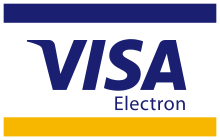Visa Electron
 The Visa Electron logo since 2015 | |
| Product type | Debit card |
|---|---|
| Owner | Visa Inc. |
| Introduced | 1985 |
| Related brands | Visa Debit |
| Markets | Worldwide |
| Tagline | "Always on" |
| Website |
www |
Visa Electron is a debit card available across most of the world, with the exception of Canada, Australia, Ireland and the United States. The card was introduced by Visa in 1985 and is a sister card to the Visa Debit card. The difference between Visa Electron and Visa Debit is that payments with Visa Electron require that all the funds be available at the time of transfer, i.e., Visa Electron card accounts may not normally be overdrawn. Visa Debit cards, on the other hand, typically allow transfers exceeding available funds up to a certain limit. Some online stores and all offline terminals (like on trains and aircraft) do not support Visa Electron because their systems cannot check for the availability of funds.
Details
In different regions the card is issued with different specifications. For example, one bank may issue a Visa Electron debit card, while another may issue a credit card. It is most commonly issued as a debit card. An example of a Visa Electron Credit Card is the Vevo Saving Account issued by BisB in Bahrain; in which the owner of the card can deposit as much as they want and withdraw according to their premise.[1]
In addition to debit facilities, the card also allows the holder to withdraw cash from automated teller machines (ATMs) even outside the holder's country of residence unlike normal ATM cards issued in some countries. This is because Visa Electron cards are also linked to the Visa PLUS interbank network. While the card is not available in the United States, it can be used to transfer funds from other countries.
In the United Kingdom the card is not as widely accepted as the Visa Debit card.[2] As of 2015, most UK banks have migrated away from Visa Electron - of the major banks, all offer some form of Visa Debit in place of the Visa Electron card.[3] Lloyds TSB (now Lloyds Bank and TSB), Barclays, Halifax Bank, Santander and The Co-operative Bank formerly issued the card - all have now instead moved to "all authorised" Visa Debit cards for basic account holders.
In countries that have stricter criteria for issuing credit cards Visa Electron has become popular with younger people and students. As each transaction requires funds to be checked, accounts cannot be overdrawn. Therefore, banks will issue a Visa Electron card to customers who may not qualify for credit. In some cases, especially in the UK, rather than issuing Electron to customers who should not be allowed to go overdrawn, banks will issue a Visa Debit card that requires on-line authorisation for every transaction, but otherwise follows Visa Debit processing rules. This can cause these cards to be declined where a Visa Debit card that permits off-line use would be accepted, for example at petrol pumps or onboard trains.
Design
A Visa Electron logo, usually on the bottom right. Most Visa Electron cards do not have the dove hologram as on Visa credit and debit cards, but a few banks do include it.
The card number and validity as well as cardholder name are printed rather than embossed, thus the card cannot be used in a card imprinter - for card-present transactions the card requires a magnetic stripe reader or a chip and PIN reader.
References
- ↑ "vevo Youth Saving Account - Retail Banking - BisB". Retrieved 17 November 2015.
vevo is a youth account from BisB that gives you more - benefits, more choices and more independence.
- ↑ Electron users blocked online BBC News
- ↑ Visa Electron cards to be phased out BBC News